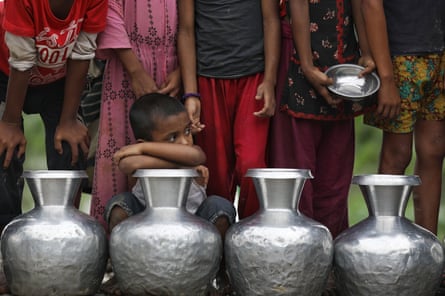Half of children in poorer countries have lead poisoning, says study
Urgent action is needed to tackle the “staggering damage” caused by lead poisoning, especially in low-income countries where more than half of children are exposed to dangerous levels of the pollutant.
A year-long project led by Washington-based think tank the Center for Global Development (CGD), has concluded that lead poisoning represents a global health crisis that has been “extremely neglected” by donors and political leaders.
An estimated 815 million children – one in three worldwide – have this lead poisoning, a condition linked to heart and kidney disease, reduced intelligence, violent behavior and premature death. Last month is one article in Lancet Planetary Health It is estimated that in 2019, 5.5 million people died from cardiovascular disease caused by lead poisoning, about three times the number of deaths from lung cancer.
Quick guide
A common condition
Show
The human toll of non-communicable diseases (NCDs) is enormous and rising. These diseases end the lives of about 41 million of the 56 million people who die each year – and three-quarters of them are in the developing world.
NCDs are simply that; Unlike a virus, for example, you cannot contract them. Instead, they are caused by a combination of genetic, physiological, environmental and behavioral factors. The main types are cancer, chronic respiratory diseases, diabetes and cardiovascular disease – heart attacks and strokes. About 80% are preventable, and all are increasing and spreading inexorably around the world as aging populations and lifestyles, pressured by economic growth and urbanization, make unhealthy living a global phenomenon.
NCDs, once seen as diseases of the rich, now have a hold on the poor. Disease, disability, and death are perfectly designed to create and increase inequality—and if you’re poor, you’re less likely to receive an accurate diagnosis or treatment.
Investment in tackling these common and chronic conditions, which kill 71% of us, is incredibly low, while the costs to families, economies and communities are staggeringly high.
In low-income countries, NCDs – typically slow and debilitating diseases – see a fraction of the money needed being invested or donated. Attention remains focused on the threats of communicable diseases, but cancer death rates have long surpassed the death tolls from malaria, tuberculosis and HIV/AIDS combined.
‘A Common Condition’ is a Guardian series reporting on NCDs in the developing world: their prevalence, solutions, causes and consequences, and telling the stories of people living with these diseases.
Tracy McVeigh, editor
The World Bank calculates that the cost of premature deaths is equal to $4.6 trillion, or 5.3% of global GDP. The effects of lead poisoning also pose a significant barrier to achieving almost all of the UN’s Sustainable Development Goals, the report said.
Children are the most vulnerable to the condition because they are more likely to put lead objects in their mouths (for example, toys covered in lead paint) and because their bones and organs absorb more of the metal once consumed. In addition, lead, a neurotoxin, can more easily cross the blood-brain barrier at a younger age, where it can seriously affect mental development.
In July a working document published by the CGD collected 47 studies to show that the more leading children are exposed to, the lower their test scores are in math, reading and IQ. The CGD found that about a fifth of the total gap in test scores between children in rich and poor countries is due to differences in lead exposure.
Strict laws and billions of dollars to address the causes of poisoning prevent most children in wealthy countries from coming into contact with significant amounts of lead. That’s not the case in poorer countries, where the metal is still used in commercial products such as paint (which can flake off and create dust that people breathe), traditional medicines and spices, as well as lead-glazed cookware, which can leach into food.

The inability to create buffer zones between mining waste facilities and residential areas also contributes to soil and air pollution in poor countries, as well as the lack of well-enforced safety and environmental standards recyclers of lead-acid batteries.
As a result, it is estimated that more than half of all children in low-income countries have lead poisoning – in rich countries this is only 3%. During the height of the water crisis in Flint, Michigan, where lead was found in drinking water, less than 4% of Flint’s children were clinically poisoned.
According to the CGD, an estimated $350 million in targeted aid between 2024 and 2030 would be enough to dramatically reduce lead exposure in lower-income countries, provided there is sufficient commitment from political leaders. Funding requirements include donations for lead testing equipment, support with advocacy and awareness campaigns, and technical assistance with regulatory development and enforcement.
But the CGD found that annual philanthropic funds to prevent and reduce lead exposure in low- and middle-income countries amount to only $11 million.
The CGD statement says dramatic action is needed to end the “slowly evolving crisis” and calls on development agencies and banks to support governments in low- and middle-income countries to develop national strategies that promote regulation and greater include consciousness.
In the short term, reducing infections, for example by withdrawing products from the market, can have a significant impact.

A 2019 study in Bangladesh found that turmeric was often adulterated with lead to make it brighter, and that this was the main source of lead exposure in the areas tested. In response, external donors helped sponsor an initiative with the Bangladesh Food Safety Authority and experts to educate the public about the dangers of lead. They also warned consumers to avoid bright yellow turmeric and informed suppliers of the legal penalties for lead adulteration. Health inspectors were then trained to test turmeric samples at a major wholesale market in the capital Dhaka, and violators were fined.
Researchers discovered this in 2019Just before this campaign, almost half of the turmeric sampled in Dhaka’s main wholesale market contained detectable levels of lead. By 2021, a year after the initiative, this had fallen to zero.
